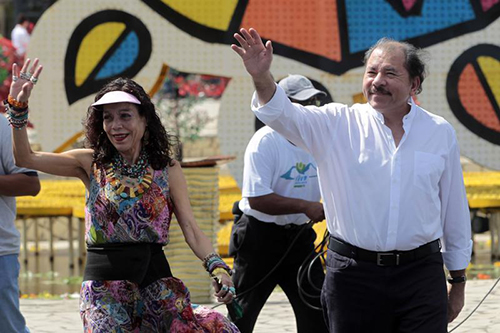It’s been nearly 3,000 days since Nicaraguan President Daniel Ortega last held a news conference, according to the opposition newspaper La Prensa. But when journalists complain about the lack of access to Ortega they often direct their ire not at the president but at the first lady, Rosario Murillo.
Murillo, 63, is the government’s communications czar and chief architect of its strategy of shutting out independent media while fielding the occasional softball question from pro-government news outlets, independent Nicaraguan reporters told the Committee to Protect Journalists.
And it’s not just Ortega who has clammed up. Government ministers avoid critical journalists on the orders of Murillo, Lucydalia Baca, an editor at La Prensa, said. A 2009 special report by CPJ found that the government tries to harasses and smear independent reporters, and manipulate state advertising to punish critical media and reward allies–practices that continue, journalists told CPJ.
Even when it comes to the biggest story in recent Nicaraguan history–plans to construct a $50 billion transoceanic canal that could transform the country–reporters trying to get information from the government about how the project will be financed and its possible environmental impact say they have run into major roadblocks.
The chief source of official information is Murillo, who appears on television nearly every day to promote government policies and activities–with no opportunity for journalists to ask questions. Like her husband, Murillo refuses nearly all requests for interviews, including a recent one from CPJ.
“Her strategy is to ‘decontaminate’ information, which means that the people should hear exactly what the government wants to tell them,” an editor at a Managua newspaper, who asked not to be named out of job security concerns, told CPJ. “That means going around independent journalists.”
“It is a very primitive concept,” Carlos Fernando Chamorro, editor of the independent Confidencial newsletter, told CPJ. “There is an official monologue with zero debate, zero questions and zero transparency.”
A poet, Murillo once worked as a secretary for Chamorro’s father, La Prensa editor Pedro Joaquin Chamorro, whose 1978 assassination turned many Nicaraguans against dictator Anastasio Somoza. Eventually, Murillo joined the Sandinista guerrilla movement and was briefly arrested in 1976. She then fled to Costa Rica where she became involved with Ortega–one of the nine top Sandinista commanders–and helped launch Radio Sandino, the movement’s clandestine station.
By the time the Sandinistas overthrew Somoza in July 1979, Murillo and Ortega were a couple. They married in 2005. During the 1979-1990 Sandinista revolutionary government that was headed by Ortega, Murillo’s role was limited because Ortega shared power with the eight other rebel commanders who made up the Sandinista National Directorate
Murillo’s rise to influence, according to many analysts and news reports, coincided with a scandal involving allegations of incest. In 1998, Murillo’s daughter from a previous relationship, Zoilamérica Narváez, accused Ortega of sexually abusing her from the age of 11. Ortega denied the accusations, which were thrown out in 2001 by the Supreme Court because the statute of limitations had expired. Through it all, Murillo reportedly backed Ortega and called her daughter mentally unstable and a political enemy.
“In exchange,” wrote Kenneth E. Morris in his Ortega biography Unfinished Revolution, “Murillo extracted real political power” from Ortega.
Chamorro told CPJ: “It is obvious that after the Zoilamérica crisis, Murillo’s political role grew.”
After three failed reelection bids–in 1990, 1996, and 2001–Murillo helped manage Ortega’s political comeback. She promoted a kinder, gentler image of Ortega and replaced the red and black colors of the Sandinista party with softer pastels that dominate billboards and government advertising. Ortega won the 2006 election and was re-elected in 2011.
Often, the Nicaraguan media has focused on Murillo’s extravagant tastes. Compared to her austere husband who favors plain white shirts, Murillo is a clotheshorse with a penchant for lots of accessories. A survey by La Prensa showed that in 463 official photographs taken over three years, the first lady wore 462 different outfits. Her speeches are peppered with references to Christian values, spirituality, and Mother Earth. She recently ordered the construction in the capital, Managua, of dozens of towering yellow metal “trees of life” that, she said, symbolize “the faith that mobilizes us.”
But beyond the New Age façade, Chamorro says, Murillo’s power is very real. She is widely considered by political analysts as a co-leader of the government with Ortega, as well as being its communications chief. During a summit in Costa Rica in January, Ortega named Murillo as his acting foreign minister. There is even speculation among analysts and supporters that she may try to succeed Ortega by running for president in 2017.
If so, she may have much of the media on her side. La Prensa and Confidencial are the only remaining print outlets in Nicaragua that regularly criticize the Ortega government. Nearly all TV and radio stations, where most Nicaraguans get their news, are owned by allies or members of the Ortega family, or provide relatively benign coverage of his government, Chamorro told CPJ.
But in an interview with CPJ, Bayardo Arce, Ortega’s top economics adviser, defended Murillo’s media strategy. After years of sensational and erroneous reporting on Ortega and the Sandinistas, Arce said, the government has decided that it will deal with “responsible” journalists only.
“Not all journalists have access to the White House,” Arce said. “So I don’t see what the problem is. In all countries, governments open the door to serious journalists and deny access to those who are irresponsible.”
[Reporting from Managua]
UPDATE: The text has been corrected to reflect that the colors of the Sandinista party are red and black.
